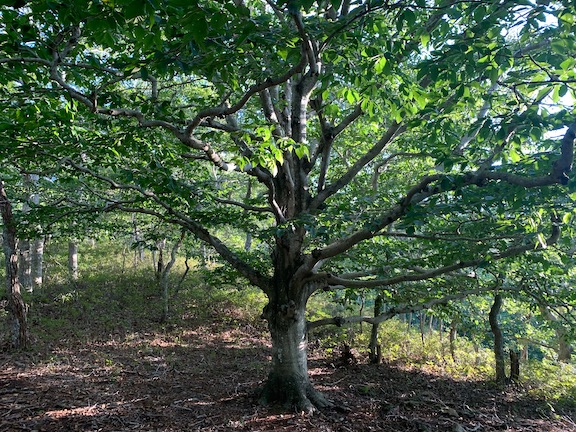From the President, Adam R. Moore
The maple by a stake and stones. The oak by the drilled hole. The pine by the ditch. All are “witness trees.”
For surveyors and foresters, the term witness tree describes a tree that is associated with a corner of a property boundary. Generally, a witness tree overlooks a marker such as a stake and stones, a cairn, a hole drilled in a rock, or—in a landscape devoid of large rocks, such as the outwash plain of the south shore of Martha’s Vineyard—a boundary defining ditch. Other witness trees might overlook a junction of stone walls, or an iron pipe, or a fence. Witness trees are referenced in surveyors’ notes and in property deeds, especially older deeds. A winter afternoon spent at the Dukes County Registry of Deeds tracing the title history of any Island property inevitably leads to a document written in elegant, cursive script with references to witness trees.
In the Forestry Handbook, foresters are instructed to find three witness trees around a property corner and paint a blaze on each of these trees so that each boundary blaze faces the corner. By triangulating with these blazes, the forester can more readily find an obscure marker, which has perhaps become hidden under layers of decaying leaves or piles of fallen branches. Though not a permanent marker, a witness tree may last for a couple of centuries, and it costs nothing to install, and therefore renders itself quite cost-effective.
There is another meaning to witness tree, though. In their own silent way, all trees are witness trees, as the rings of the tree silently record the environmental record of the world in wood. Such a record is familiar to anyone who has ever felled a tree and counted the rings on the stump, or bored a tree with an increment borer and counted the rings on the core. One can first tell the age of the tree, just by counting from the bark to the center.
Yet one can also tell—by the width of the ring—whether the year was a lean one or a good one for that tree. I recall examining the rings of hemlocks cut beside Lake Saltonstall in Branford, Connecticut. Each tree displayed a big, fat ring for the year 1939. Why 1939? Because in 1938, the great Hurricane of ‘38 felled all the other trees around this young hemlock, flooding the forest with light, and giving the sapling the space it needed to grow.
Using dendrochronology, the science of aging wooden structures through the analysis of tree rings, the tree rings present in the framing timbers of an antique house can precisely date the age of that structure. Dendrochronology performed on the oak timbers of the Hancock Mitchell House at Quansoo Farm revealed that the oak trees from which the timbers were hewn were felled in 1758 and 1759—prompting a reexamination of the history of colonial houses on Martha’s Vineyard.
Through radiocarbon dating, the wood of prehistoric trees can reveal the age of an ancient forest. For example, if one strolls the beach between Squibnocket beach and Stonewall beach, one sees the trunks of fallen trees protruding from the bluff, pointing toward the sea. These are actually ancient white pine trees, and Harvard Forest Director Dr. David Foster has studied them using radiocarbon dating. He learned that these trees, the oldest on the Island by far, are 10,000 years old.
Yet the other meaning of “witness tree” is something different. The other meaning is a tree that has witnessed events. We all have personal witness trees. From time to time, I think of such trees, and the events that they have witnessed over the course of my life.
The eastern red cedar in front of the executive director house at Quansoo has witnessed each of our children heading off for the first day of school in September as my wife, Melissa, and I posed the children for a picture. Not long ago, four children posed for this annual photo; this year, we were down to just one. The tulip poplars at Sheriff’s Meadow Sanctuary witness my periodic perambulations of this property. The beeches at Cedar Tree Neck have now witnessed many years of vigorous Moore family hikes. In these cases, the witness trees are very familiar. The trees and I witness each other frequently, and sometimes daily.
In other cases, though, witness trees are less familiar. When we brought our daughter Ingrid to college at the end of the summer, we paused in the shade of a massive American elm. Gazing up at the elm’s arching branches, my son, Huck, pointed out that I had walked beneath this very same tree 34 years ago. Startled, I looked up at the elm, and thought for a bit. That same elm was still there. Silently, the arching elm towered over me, back again. I took a deep breath, and breathed out. The elm breathed in, turned my breath into wood, and witnessed me. Sometimes, witness trees surprise us.






